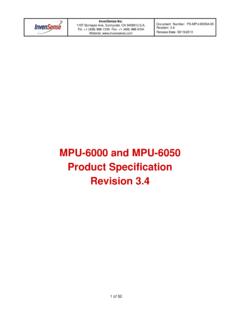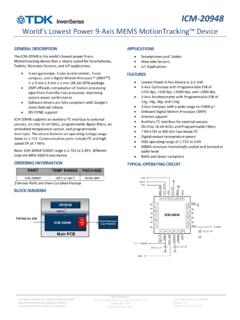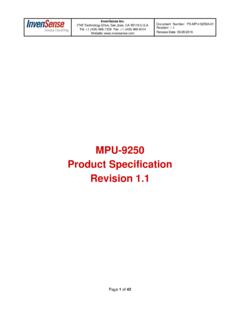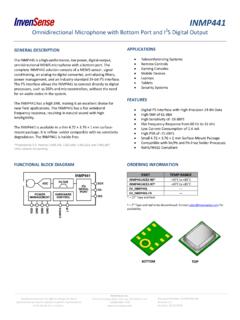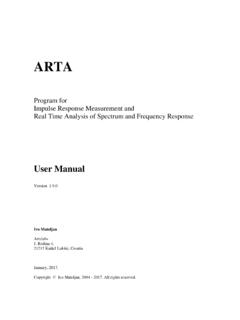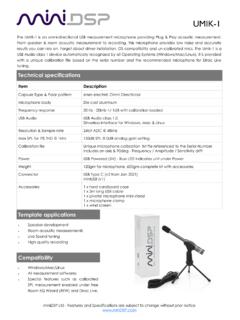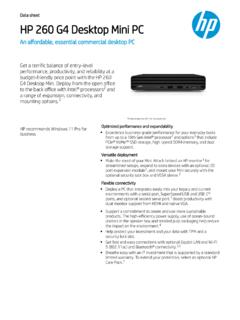Transcription of MICROPHONE SPECIFICATIONS EXPLAINED - TDK
1 Application Note AN 1112 MICROPHONE SPECIFICATIONS EXPLAINED InvenSense reserves the right to change the detail SPECIFICATIONS as may be required to permit improvements in the design of its products. InvenSense Inc. 1745 Technology Drive, San Jose, CA 95110 +1(408) 988 7339 Document Number: AN 1112 Revision: Release Date: 06/15/2016 DB FS INTRODUCTION A MEMS MICROPHONE IC is unique among InvenSense, Inc., products in that its input is an acoustic pressure wave. For this reason, some SPECIFICATIONS included in the data sheets for these parts may not be familiar, or familiar SPECIFICATIONS may be applied in unfamiliar ways. This application note explains the SPECIFICATIONS and terms found in MEMS MICROPHONE data sheets so that the MICROPHONE can be appropriately designed into a system.
2 SENSITIVITY The sensitivity of a MICROPHONE is the electrical response at its output to a given standard acoustic input. This is expressed as the ratio of the input pressure to the electrical output (voltage or digital word). The standard reference input signal for micro phone sensitivity measurements is a 1 kHz sine wave at 94 dB sound pressure level (SPL), or 1 pascal (Pa, a measurement of pressure). A MICROPHONE with a higher sensitivity value has a higher level output for a fixed acoustic input than a MICROPHONE with a lower sensitivity value. MICROPHONE sensitivity in decibels (dB) is typically a negative number; therefore, a higher sensitivity is a smaller absolute value. It is important to note the units presented with the sensitivity SPECIFICATIONS of the MICROPHONE .
3 It is incorrect to directly compare the sensitivity of two microphones if the sensitivity is not specified with the same unit. For analog microphones, the sensitivity is typically specified in units of dBV, that is, decibels with reference to V rms. For digital microphones, the sensitivity is typically specified in dB FS, that is, decibels with reference to a full scale digital output (0 dB FS). For digital microphones, a full scale signal is defined as the highest signal level that can be output from the MICROPHONE ; for InvenSense MEMS microphones, this level is 120 to 140 dB SPL. See the Acoustic Overload Point section for a fuller description of this signal level. A MICROPHONE s sensitivity tolerance indicates the range of sensitivity for any given individual MICROPHONE .
4 In the data sheet, this is shown as the minimum and maximum sensitivity specification, but is commonly discussed in terms of plus/minus some dB value. The sensitivity tolerance of InvenSense MICROPHONE ranges from 1 dB to 3 dB. Analog microphones sensitivity can be measured with units mV/Pa. This measurement is converted to a decibel value with the following equation: REFPamVdBVOutputySensitivitySensitivit/1 0log20 where, OutputREF is the 1 V/Pa (1000 mV/Pa) reference output ratio. For digital microphones, sensitivity is measured as a percentage of the full scale output that is generated by a 94 dB SPL input. For a digital MICROPHONE , the conversion equation is REFFSdBFSO utputySensitivitySensitivit%10log20 Where, OutputREF is the full scale digital output level ( ).
5 AN 1112 Document Number: AN 1112 Page 2 of 11 Revision: Rev Date: 06/15/2016 The sensitivity of a PDM output MICROPHONE is specified in units of dB FS (decibels relative to a full scale digital output). A 0 dB FS sine wave is defined as a signal whose peak just touches the full scale code of the digital word (see Figure 1). This measurement convention means that signals with a different crest factor may have an rms level higher than 0 dB FS. For example, a full scale square wave has an rms level of 3 dB FS. Figure 1. 1 kHz, 0 dB FS Sine Wave The definition of a 0 dB FS signal must be understood when measuring the sensitivity of a digital MICROPHONE . An acoustic input signal of a 1 kHz sine wave at 94 dB SPL applied to a digital MICROPHONE like the INMP521 results in an output signal with a 26 dB FS level.
6 This means that the output digital word peaks at 26 dB below the digital full scale level. A common misunderstanding is that the output has an rms level of 29 dB FS; however, this is not the case because of the definition of a 0 dB FS sine wave. There is no commonly accepted unit of measurement to express the instantaneous level of a digital signal output from the MICROPHONE , as opposed to the rms level of the signal. Some measurement systems express the instantaneous level of an individual sample in units of D, where D is digital full scale (see Figure 1). In this case, a 26 dB FS sine wave has peaks at D. Higher sensitivity does not always indicate a better MICROPHONE . A MICROPHONE with higher sensitivity typically has less headroom between the output level under typical conditions, such as conversational speech, and the maximum output level.
7 In near field (close talking) applications, a MICROPHONE with higher sensitivity is more likely to cause distortion. This distortion often reduces the overall dynamic range of the MICROPHONE . DIRECTIONALITY Directionality describes the pattern in which the MICROPHONE s sensitivity changes when the sound source changes position in space. All InvenSense MEMS microphones are omnidirectional (or omni), which means that they are equally sensitive to sound coming from all directions, regardless of the orientation of the MICROPHONE . Figure 2 shows a 2 axis polar plot of the MICROPHONE s response . This plot looks the same regardless of whether the MICROPHONE s port is oriented in the x y, x z, or y z plane. AMPLITUDE (D)TIME (ms) AN 1112 Document Number: AN 1112 Page 3 of 11 Revision: Rev Date: 06/15/2016 Figure 2.
8 Omnidirectional MICROPHONE response Plot The directional response of a system may not be omnidirectional when an omni MICROPHONE is designed into a larger enclosure, such as a cell phone. For the system designer, an omnidirectional MICROPHONE provides greater flexibility in the design of the system response to an acoustic input than if the MICROPHONE itself has a directional response . Multiple omnidirectional microphones can be arranged in arrays to create various directivity patterns and for beamforming applications. SIGNAL TO NOISE RATIO (SNR) The signal to noise ratio (SNR) specifies the ratio of a reference signal to the noise level of the MICROPHONE output. This measurement includes noise contributed by both the MICROPHONE element and the ASIC incorporated into the MEMS MICROPHONE package.
9 The SNR is the difference in decibels between the noise level and a standard 1 kHz, 94 dB SPL reference signal. SNR is calculated by measuring the noise output of the MICROPHONE in a quiet, anechoic environment. This specification is typically presented over a 20 kHz bandwidth as an A weighted value (dBA), which means that it includes a correction factor that corresponds to the human ear s sensitivity to sound at different frequencies. When comparing SNR measurements of different microphones, it is important to make sure that the SPECIFICATIONS are presented using the same weighting and bandwidth; a reduced bandwidth measurement makes the SNR specification better than it is with a full 20 kHz bandwidth measurement. EQUIVALENT INPUT NOISE (EIN) Equivalent input noise (EIN) is the output noise level of the MICROPHONE , expressed in dB SPL, as a theoretical external noise source placed at the MICROPHONE s input.
10 Input SPLs below the EIN level are under the noise floor of the MICROPHONE and outside the dynamic range of signals for which the MICROPHONE produces an output. EIN can be derived from either the dynamic range or SNR specification as follows: EIN = acoustic overload point dynamic range EIN = 94 dB SNR The EIN of a MICROPHONE with 62 dB SNR and 120 dB acoustic overload point is 32 dB SPL approximately the SPL that would be generated by a soft whisper in a quiet library at a distance of 5 meters. Figure 3 and Figure 4 show the EIN of the microphones. DYNAMIC RANGE The dynamic range of a MICROPHONE is a measure of the difference between the loudest and quietest SPLs to which the MICROPHONE responds linearly. The dynamic range of a MICROPHONE is not the same as its SNR (in contrast with audio ADCs or DACs, where the dynamic range and SNR are typically equivalent).

